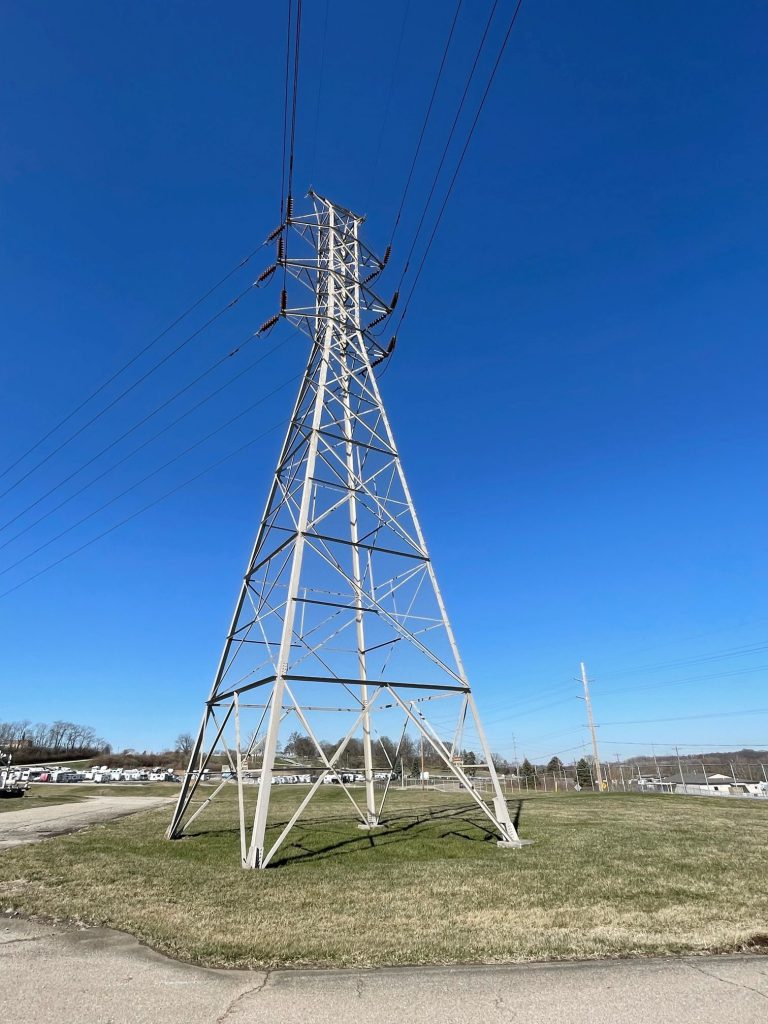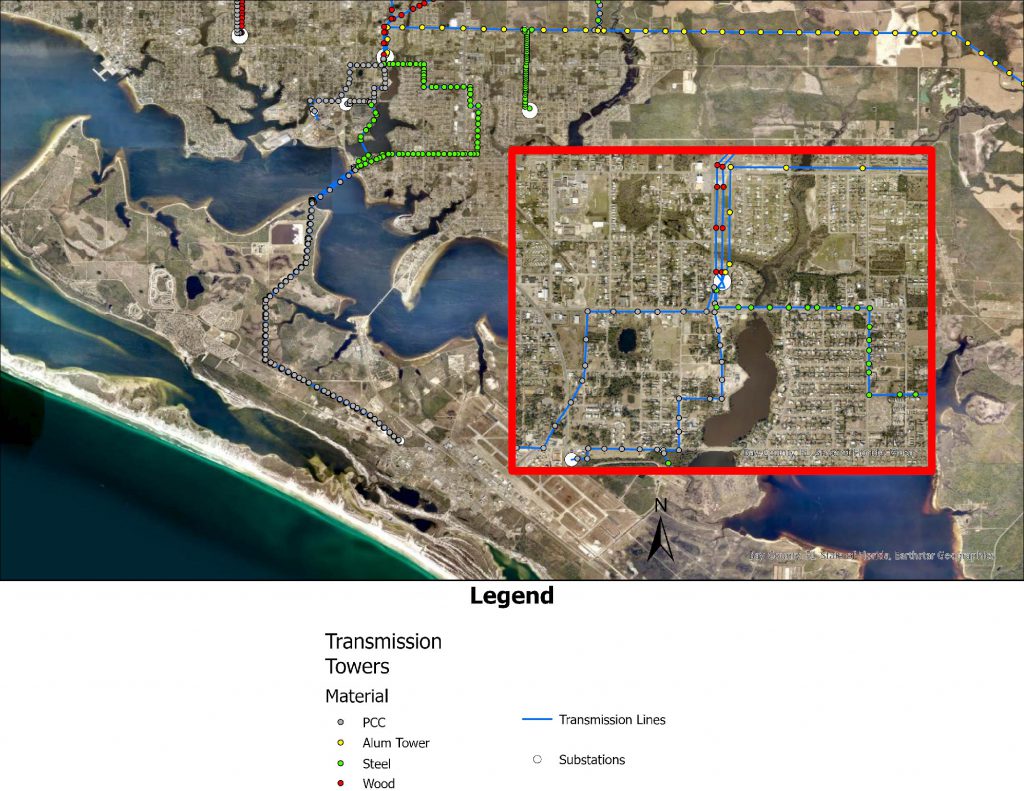By Maj. Zachary Schumann, P.E., USAF, and Christopher Chini, Ph.D.
Hurricanes commonly disrupt power system operations along both the Gulf and Atlantic coasts. The severity of the economic impacts resonating from transmission outages underscores a need to understand, quantify, and enhance power grid resilience subjected to such threats.
There are two primary approaches to estimating a grid’s response to an extreme weather event: statistical models and fragility-based models. Although statistical models provide successful implementation and accurate estimates at a spatial unit scale (such as a zip code or census tract), they do not provide accurate results at a component level, which is a feature of fragility-based models. A research study conducted at the Air Force Institute of Technology created a component-level model of the Florida Panhandle’s transmission grid across nine counties to enable fragility-level assessments to scale up resilience efforts. This work can help target assets for replacement to avoid vulnerabilities and increase the resilience of the grid, specifically with respect to the four military installations in the region.

Understanding the Components
The location and physical characteristics of transmission structures are critical in accurately modeling hurricane-induced wind damage. Different sites experience varying wind speeds based on probabilistic hurricane simulations. Wood, steel, concrete, and aluminum lattice and guyed mast structures have distinct failure loadings. Additionally, each of these materials experience a varying rate of deterioration in terms of resistive moment to wind loading because of their age.
Design standards governing the construction material and wind load ratings of transmission structures have evolved over time to account for extreme wind. The 2007 version of the National Electrical Safety Code incorporated “extreme wind and ice” loading criteria for utility structures and adopted standards for wind loading from ASCE 7-98, Minimum Design Loads for Buildings and Other Structures. These design standards apply to any structure 18-m or greater in height and broadly require all transmission support structures to meet wind loading up to 130-mph. Structures erected prior to this revision are required to meet National Electrical Safety Code Grade B requirements in the Florida Panhandle and an equivalent wind loading standard of 105-mph.

The difference in these design standards requires an understanding of the state of the current system at the component level.
The research study first built a comprehensive dataset of the electricity grid and identified essential characteristics through open data forums and historical records. Using this component-level data, the team simulated wind speeds for multiple storms using the Hazus 5.1 software. A fragility-based analysis predicts the probability of each transmission tower being damaged based on its wind speed exposure. The predictive assessments provide three key advantages: damage estimation, actionable insight, and adaptability and scalability.
The primary results of the analysis are damage estimations based on structure location and characteristics. For example, using a simulated recreation for Hurricane Michael, the study identified almost 1,100 transmission towers with a probability of failure greater than 75 percent. The team also simulated a 200-year storm that would bisect the region. The system in this area is largely comprised of wooden towers, with almost 3,400 towers having a probability of failure above 75 percent in such an event.
The model can be used to produce just-in-time estimates of damage to the electric transmission network to optimize recovery and enable disaster preparation. Additionally, leadership can utilize models to forecast hurricane frequency, probability, and intensity under climate change. The damage estimations can provide important insight for risk-based infrastructure upgrades.
Identifying Vulnerabilities
More specifically for the Department of Defense, this analysis provides opportunities for actionable insights to bolster asset robustness, identify vulnerabilities, and predict the duration of transmission-level outages. For example, distilling the transmission lines onto Tyndall AFB through its components shows a mostly robust system from the upstream transmission substation to the installation’s primary distribution substation along steel or concrete monopole structures. However, the transmission lines feeding this upstream transmission substation are supported by wooden towers, which are not as robust to high winds. This analysis provides the base with opportunities to identify vulnerable sections of the transmission grid and advocate for resilience improvements.
The study also identified transmission line types on the electric grid, noting differences in material that could be vulnerable to higher temperatures from climate change and intensifying heat waves. The study provides important data to enable installations to make risk-informed decisions for targeted asset hardening, which could include the replacement of structures or additional enhancements to improve performance under high wind speeds. Finally, while this study investigated electric transmission infrastructure, the underlying framework for assessing system performance using component-level fragility is an important consideration, which could be more widely adapted.
For example, the Defense Department maintains large infrastructure asset portfolios tracked through sustainment management software, such as BUILDER. There are distinct opportunities to leverage these existing data, paired with fragility curves that model the probability of failure given a stressor (not limited to wind speed). Roof systems, airfield lighting, electric distribution lines, or whole facilities can be modeled at the component level, with their damage probabilities scaled to the systems level. The resulting analysis can then be used to develop resilience strategies across a variety of assets for targeted rehabilitation or replacement, enhancing decision-making capability.
Advancing Decision-Making
This Air Force study generated a unique publicly available data set to model component-level failures across a nine-county region. Tracking basic asset management characteristics of the components enabled system level assessments of vulnerability. Specifically, the analysis highlighted how the dataset and damage simulation can provide just-in-time damage assessments and opportunities for advanced disaster preparedness; targeted investment in the electric grid; and a scalable framework that can be used across a wide variety of defense assets.
Significant opportunities exist to utilize these findings to advance data collection and modeling to other installations and advance risk-based decision-making for military infrastructure.
Maj. Zachary Schumann, P.E., USAF, is Operation Flight Commander, 11th Civil Engineer Squadron, Joint Base Anacostia-Bolling, D.C.; zachary.schumann.2@us.af.mil.
Christopher Chini, Ph.D., is Assistant Professor, Air Force Institute of Technology; christopher.chini.1@au.af.edu.
More News from TME
-

Quantifying Risk Through Probabilistic Risk Assessments
Research conducted at the Air Force Institute of Technology tested the feasibility of using existing facility condition and work task data to quantify the risk of mission failure due to infrastructure limitations and subsequently use the assessment to inform future funding decisions. -

Assessing Mobile Nuclear Reactor Usage in the Pacific
A research team at the Air Force Institute of Technology carried out a lifecycle assessment of the environmental impacts, operational viability, and logistical considerations of mobile nuclear reactors in the Indo-Pacific. -

TME March-April 2025
The March-April 2025 issue of TME features articles on energy security and energy resilience, an inside look at Exercise KEEN SWORD 2025, and a leader profile of Brig. Gen. Patrick Miller, P.E., F.SAME, USAF, Commander of the Air Force Civil Engineer Center.